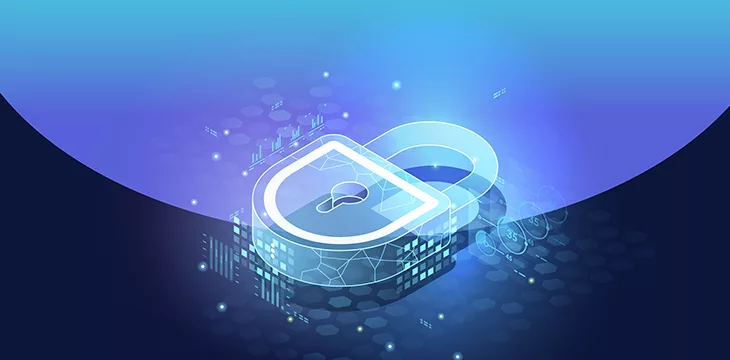Artificial intelligence (AI) is continuously progressing across industries, and it’s no different with blockchain technology. With its ability to process large amounts of data and make sound analyses, AI can provide solutions to strengthen blockchain security. AI in blockchain has the potential to make real-world systems more secure, intelligent, and efficient.
In this infographic, you’ll learn about AI-driven solutions for blockchain security while exploring how the two technologies work together to redefine data security. You’ll also understand how AI can monitor the blockchain for any unusual activity or changes in data, alerting administrators to potential security breaches.

AI and Blockchain
The overlap between AI and blockchain is a positive one, with both technologies potentially revolutionizing many industries. AI empowers machines to aid humans in decision-making, whereas blockchain technology’s decentralized ledger ensures secure, transparent, and immutable applications.
Simply put, AI can help make sense of the information stored in a blockchain and help protect and secure it. It can look for patterns, spot errors, and even predict things based on the data in the blockchain.
Their combined strength makes AI and blockchain unbeatable. Together, they can bolster the security, transparency, and operational efficiency of various sectors. This dynamic duo offers several benefits, including:
- Data management − AI and blockchain technology can enhance data management, privacy, and security in various industries by facilitating secure storage and sharing.
- Transparency − The blockchain and AI merge is transforming different industries by bringing new transparency, security, and efficiency levels.
- Decentralization − AI and blockchain offer autonomous and decentralized solutions, which help reduce data breaches and cyberattacks.
- Data sharing and privacy − Blockchain technology can create decentralized data marketplaces and governance frameworks, enabling participants to decide on data access and sharing as a group.
- Immutable data structure − AI algorithms can process sensitive information, thanks to blockchain’s secure and unchangeable data structure.
Despite these advantages, merging AI and blockchain technology faces hurdles that demand attention. For one, AI models may grapple with data collection issues. AI entities must connect to distinct datasets from different parties in such cases. Striking a balance between safeguarding data privacy and harnessing the benefits of AI can prove to be a challenging endeavor.
However, the potential for transforming various sectors by combining AI and blockchain is enormous⎯and the two technologies may grow into a billion-dollar industry within the next decade.
12 AI-Driven Solutions to Improve Blockchain Security
AI-driven solutions can significantly improve blockchain security by detecting anomalies, recognizing patterns, and predicting potential threats. Here are some examples of AI-driven solutions that can enhance blockchain security.
1. Anomaly detection
Leveraging AI for anomaly detection in smart contracts offers several advantages. AI can monitor smart contracts and detect unusual behavior that may suggest a security breach. If a smart contract suddenly starts behaving differently, such as initiating too many transactions or accessing data it’s not supposed to, the AI system can quickly flag this behavior as an anomaly.
AI models can also minimize false positives, with their ability to distinguish between benign changes in behavior and actual security threats.
2. Pattern recognition
Pattern recognition is the ability of AI systems to analyze and interpret data patterns within the blockchain network for potential threats and security breaches. Blockchain networks generate vast transaction data, and manual analysis is impractical. AI-powered systems excel at handling and processing massive datasets, making them well-suited for blockchain security tasks.
Additionally, AI algorithms can analyze transaction patterns, including examining historical transaction data to establish a baseline of normal behavior. AI can then detect deviations from such norms, which may indicate suspicious or fraudulent activities.
3. Predictive analysis
Predictive analysis significantly enhances blockchain security by forecasting and preemptively addressing potential threats. This approach relies on machine learning models trained on historical blockchain data. Predictive analysis algorithms can learn from patterns and trends in the data to detect future security threats.
For example, it can forecast the likelihood of a DDoS attack based on network traffic patterns, sudden increases in transaction volume, or other relevant indicators. Predictive analysis acts as an early warning system by identifying security threats before they fully materialize. As such, blockchain administrators and security teams can proactively prevent or mitigate the impending danger.
4. Smart contract auditing
Smart contract auditing offers a systematic and efficient way to assess the security of these contracts. AI-powered auditing tools can analyze the codebase of smart contracts, examining every line and function for potential vulnerabilities. These can range from common programming errors to more blockchain-specific issues.
AI can also simulate the execution of smart contracts in different scenarios to identify runtime susceptibilities. For instance, it can test contract behavior when interacting with malicious or unexpected inputs. Smart contract auditing tools can provide real-time feedback to developers and auditors as they write or review code.
This immediate feedback enables them to address vulnerabilities during the development phase, reducing the risk of deploying insecure contracts. Plus, AI can provide security recommendations, best practices, and regression testing to ensure that new changes do not introduce vulnerabilities or disrupt existing security measures.
5. Network monitoring
AI-driven network monitoring solutions are vital in identifying and mitigating threats in real time. They continuously analyze data flow and transactions within the blockchain network, scrutinizing traffic patterns like the volume, frequency, and type of transactions.
Network monitoring also has early warning capabilities and proactive threat mitigation, ensuring the integrity and reliability of blockchain networks. As blockchain technology continues to evolve and security threats become more sophisticated, AI-driven network monitoring will be indispensable in maintaining the security of decentralized systems.
6. Data privacy
Data privacy is paramount in blockchain technology, where advanced encryption algorithms secure data before storing it in the network. Blockchain data is in an unreadable format and only accessible by authorized parties.
Here, AI is vital in safeguarding sensitive information. AI uses data masking techniques to conceal sensitive information in blockchain transactions or smart contracts. The workaround is to replace sensitive details with placeholder data, preventing unauthorized users from accessing critical information.
AI can also assist in de-identifying data by removing or encrypting personally identifiable information (PII) and complying with privacy regulations like GDPR while utilizing blockchain technology.
7. Fraud detection
Since AI can examine transaction data and identify unusual patterns, behaviors, or anomalies, it can detect money laundering or fraud. It uses advanced algorithms to continuously monitor blockchain activities, providing real-time alerts and enabling prompt response to potential threats.
This proactive approach safeguards the integrity of blockchain networks, deters malicious actors, and ensures trust in decentralized blockchain platforms.
8. Decentralized identity verification
AI can enhance identity verification on the blockchain by verifying the identity of users without the need for centralized authority. For instance, AI can use biometrics like facial recognition, fingerprints, and iris scans to verify the identity on the blockchain.
These biometrics are unique to individuals, making impersonation extremely challenging. AI also enhances security by enabling multi-factor authentication (MFA) for identity verification, combining multiple authentication factors such as PINs and device authentication. As such, users have greater control over their personal information, reducing the risk of data breaches.
9. Automated incident response
Automated incident response ensures blockchain networks’ integrity and trustworthiness through rapid detection and proactive mitigation of potential threats.
For example, AI can automatically block suspicious IP addresses, DDoS attacks, and unusual transactions. AI can orchestrate dynamic responses based on the severity of the threat. It can escalate actions for critical threats and implement less severe responses for potential but less immediate risks.
10. Consensus mechanism enhancement
AI can enhance the blockchain’s consensus mechanism by optimizing the validation process and reducing the risk of attacks. For instance, AI can analyze network traffic and identify potential attacks on the consensus mechanism. It can also adapt to varying network loads, adjusting parameters like block size and transaction prioritization to accommodate increased activity without compromising security.
11. Dynamic security adjustments
Dynamic security adjustments powered by AI allow blockchain networks to respond quickly to changing threat landscapes, ensuring robust protection while minimizing disruptions. AI dynamically adjusts security policies and measures based on the detected threat.
For example, it can increase the blockchain’s required number of transaction confirmations during heightened threat activity periods. During high network traffic periods or potential attacks, AI can optimize network traffic management by prioritizing legitimate transactions and reducing the processing of potentially suspicious ones.
12. Network partitioning and recovery
AI can create partitions in the blockchain network to prevent the spread of security breaches and recover from attacks more quickly. It can isolate compromised nodes and prevent them from communicating with the rest of the network, minimizing the impact of security breaches.
Meanwhile, AI-driven recovery protocols may involve restoring compromised nodes to a known secure state, rolling back transactions, or applying patches and updates. After mitigating the threat and reinforcing security measures, AI can facilitate the safe reintegration of isolated nodes or segments back into the primary network.
AI in Blockchain: Power and Security in Business
AI is a significant factor in making blockchain a stable and safe ecosystem for various industries. With its continuous development, you can expect further advancements with blockchain. Finally, the powerful partnership between AI and blockchain can improve the security, visibility, and operational effectiveness of global ventures and economies.
When it comes to blockchain, CoinGeek is the perfect place to learn more about this technology. We have informative resources that break down and help newbies digest all there is to know about blockchain. Check out our collection of blockchain for beginners articles today.

 09-17-2025
09-17-2025 



